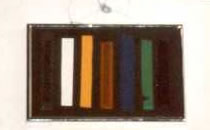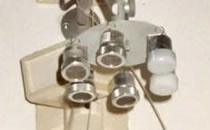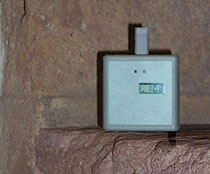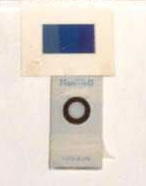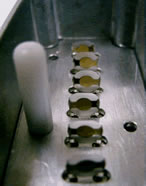1.- PAINT DOSIMETER
This is being used to monitor levels of relative humidity, temperature, light and air pollution. It consists of a series of tempera paint strips of various pigments mounted on a polymeric substrate. The previous project (ERA) demonstrated that the principle of paint based dosimetry works; the task of this project is to implement the use of the paint temperas and to further calibrate their performance by exposure in studied environments.
2. PASSIVE SAMPLERS
These are used to evaluate air quality for levels of NO2, SO2, O3 and HONO. They consist of small glass flasks mounted on metallic carousel. Each of these carousels holds six flasks, four of which are exposed to the air and two of which remain closed and act as a control. Each flask contains a series of substances specifically sensitive to the pollutant they are measuring.
3. HANWELL HUMBUG (Relative Humidity/Temperature monitor)
This is a device used to monitor temperature and relative humidity fluctuations. It is capable of recording data at short intervals (set by user), accumulating them in its memory. These data may be obtained as spot measurements at any given moment, or downloaded onto computer, using the Hanwell Humbug programme, to give a continuous picture of weather conditions in a given location over a specific period.
4. HANWELL LUXBUG (Light intensity monitor)
Like the Humbug, this device takes readings at set intervals (hourly or as required), storing them in its memory. The accumulated data can be downloaded, using the specific Hanwell Luxbug programme, to give a picture of variations in light levels in a given location over a specific period.
5. PIEZOELECTRIC QUARTZ CRYSTAL DOSIMETER (PQC)
This device is still being developed by scientists working on the project. The aim is to to create an instrument capable of monitoring damage produced by pollutants, light, humidity and other elements surrounding art works in museums. Reactions of the coated PQC's produce measurable signals (eg resonance frequency changes) and so direct read-outs of damage may be obtained without having to make lengthy laboratory analyses.
